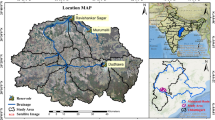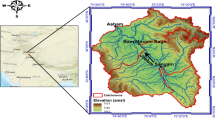Abstract
Sensitivity analysis (SA) is widely acknowledged as advantageous and worthwhile in recognizing parameters for model calibration and optimization, especially in complex hydrological models. Although Sobol global SA is an efficient way to evaluate the sensitivity indices, the computational cost is a constraint. This study analyzes the potential of Morris global SA to achieve results tantamount to Sobol SA, at a much cheaper computational expense, using a new approach of increasing the number of replications for the Morris algorithm. SA for two catchments is performed on a coupled hydrological model using Morris and Sobol algorithms. Two target functions are used for each of the algorithms. Sobol SA required 660000 model simulations accounting for about 400 computing hours, whereas increasing the replications from 1000 to 3000, the Morris method called for 63000 runs and 06 computing hours to produce significantly similar results. The Morris parameter ranking improved 50% with respect to Sobol SA by a three-fold increase in replications with a small 5-h increase in the computational expense. The results also suggest that target functions and catchments influence parameter sensitivity. The new approach to employ the Morris method of SA shows promising results for highly parameterized hydrological models without compromising the quality of SA, specifically if there are time constraints. The study encourages the use of SA, which is mainly skipped because of higher computational demands.








Similar content being viewed by others
References
Andrews FT, Croke BFW, Jakeman AJ (2011) ‘An open software environment for hydrological model assessment and development’. Environ Model Softw. Elsevier Ltd, 26(10):1171–1185. https://doi.org/10.1016/j.envsoft.2011.04.006
Bárdossy A (1998) Generating precipitation time series using simulated annealing. Water Resour Res 34(7):1737–1744. https://doi.org/10.1029/98WR00981
Blasone R et al (2008) Generalized likelihood uncertainty estimation (GLUE) using adaptive Markov Chain Monte Carlo sampling. AdvWater Res Elsevier Ltd 31(4):630–648. https://doi.org/10.1016/j.advwatres.2007.12.003
Box GEP, Jenkins GM (1976) Time series analysis: forecasting and control. Holden-Day San-Francisco:588
Burnash RJC (1995) Computer models of watershed hydrology, in Singh, V. P. (ed.) The NWS river forecast system - catchment modeling. Water Resources Publications, Colorado, USA 311–366.
Burnash RJC, Ferral RL, McGuire RA (1973) A generalized streamflow simulation system: conceptual modeling for digital computers. U. S. National Weather Service, Sacramento, California
Campolongo, F. and Saltelli, A. (1997) ‘Sensitivity analysis of an environmental model: an application of different analysis methods’, Reliability Engineering and System Safety, 57(1) 49–69. https://doi.org/10.1016/S0951-8320(97)00021-5.
Campolongo F, Cariboni J, Saltelli A (2007) An effective screening design for sensitivity analysis of large models. Environ Model Softw 22(10):1509–1518. https://doi.org/10.1016/j.envsoft.2006.10.004
Carpenter TM, Georgakakos KP, Sperfslagea JA (2001) On the parametric and NEXRAD-radar sensitivities of a distributed hydrologic model suitable for operational use. J Hydrol 253(1–4):169–193. https://doi.org/10.1016/S0022-1694(01)00476-0
Castillo E, Minguez R, Castillo C (2008) Sensitivity analysis in optimization and reliability problems. Reliab Eng Syst Saf 93(12):1788–1800. https://doi.org/10.1016/j.ress.2008.03.010
Feng Z, Niu WJ, Liu S, Luo B, Miao SM, Liu K (2020) ‘Multiple hydropower reservoirs operation optimization by adaptive mutation sine cosine algorithm based on neighborhood search and simplex search strategies’, Journal of Hydrology. Elsevier B.V 590 125223. https://doi.org/10.1016/j.jhydrol.2020.125223
Gan Y, Duan Q, Gong W, Tong C, Sun Y, Chu W, Ye A, Miao C, di Z (2014) ‘A comprehensive evaluation of various sensitivity analysis methods: a case study with a hydrological model’, Environmental Modelling and Software. Elsevier Ltd 51:269–285. https://doi.org/10.1016/j.envsoft.2013.09.031
Gupta HV, Sorooshian S, Yapo PO (1998) Toward improved calibration of hydrologic models: multiple and noncommensurable measures of information. Water Resour Res 34(4):751–763. https://doi.org/10.1029/97WR03495
Hamon WR (1963) Computation of direct runoff amounts from storm rainfall. Int Assoc Sci Hydrol Publ 63:52–62
Herman JD, Kollat JB, Reed PM, Wagener T (2013) Technical note: method of Morris effectively reduces the computational demands of global sensitivity analysis for distributed watershed models. Hydrol Earth Syst Sci 17(7):2893–2903. https://doi.org/10.5194/hess-17-2893-2013
Iooss B et al (2020) Sensitivity: global sensitivity analysis of model outputs. R Package Version 1(17):1
Jahangiri M, Hadianfard MA, Najafgholipour MA, Jahangiri M, Gerami MR (2020) ‘Interactive autodidactic school: a new metaheuristic optimization algorithm for solving mathematical and structural design optimization problems’, Computers and Structures. Elsevier Ltd 235:106268. https://doi.org/10.1016/j.compstruc.2020.106268
Kirkpatrick S, Gelatt CD, Vecchi MP (1983) Optimization by simulated annealing. Science 220(4598):671–680. https://doi.org/10.1126/science.220.4598.671
Kokkonen, T. et al. (2006) Construction of a degree-day snow model in the light of the ten iterative steps in model development, Proceedings of the iEMSs 3rd Biennial Meeting, Summit on Environmental Modelling and Software.
Kokkonen T et al (n.d.) Computational methods for water resource assessments: an exercise kit. Educational Series on Modelling and Software, International Modelling and Software Society ( iEMSs)
McCuen RH (1973) The role of sensitivity analysis in hydrologic modeling. J Hydrol 18:37–53. https://doi.org/10.1016/0022-1694(73)90024-3
Mirjalili S (2016) ‘SCA: A sine cosine algorithm for solving optimization problems’, Knowledge-Based Systems. Elsevier B.V 96 120–133. https://doi.org/10.1016/j.knosys.2015.12.022
Morris MD (1991) Factorial sampling plans for preliminary computational experiments. Technometrics 33(2):161–174. https://doi.org/10.1080/00401706.1991.10484804
Pai, D. S. et al. (2014) ‘Development of a new high spatial resolution (0.25° × 0.25°) long period (1901-2010) daily gridded rainfall data set over India and its comparison with existing data sets over the region’, MAUSAM, 65 (1) 1–18.
Qi, W. et al. (2016) ‘Quantifying dynamic sensitivity of optimization algorithm parameters to improve hydrological model calibration.’, Journal of Hydrology. Elsevier B.V 533 213–223 https://doi.org/10.1016/j.jhydrol.2015.11.052.
Rakovec O, Hill MC, Clark MP, Weerts AH, Teuling AJ, Uijlenhoet R (2014) Distributed evaluation of local sensitivity analysis. Water Resour Res 50(1):409–426. https://doi.org/10.1002/2013WR014063
Rosolem R, Gupta HV, Shuttleworth WJ, Zeng X, de Gonçalves LGG (2012) A fully multiple-criteria implementation of the Sobol’ method for parameter sensitivity analysis. J Geophys Res-Atmos 117(7):1–18. https://doi.org/10.1029/2011JD016355
Saint-Geours N, Grelot F, Bailly JS, Lavergne C (2015) Ranking sources of uncertainty in flood damage modelling: a case study on the cost-benefit analysis of a flood mitigation project in the Orb Delta, France. Journal of flood risk management 8(2):161–176. https://doi.org/10.1111/jfr3.12068
Saltelli A (2002) Making best use of model evaluations to compute sensitivity indices. Comput Phys Commun 145(2):280–297. https://doi.org/10.1016/S0010-4655(02)00280-1
Saltelli, A., Chan, K., Scott, E. M. (2000) Sensitivity analysis. Probability and Statistics Series.John Wiley & Sons, Ltd
Saltelli, A. et al. (2004) Sensitivity analysis in practice: a guide to assessing scientific models. John Wiley & Sons, Ltd
Saltelli, A. et al. (2008) Global sensitivity analysis: the primer. John Wiley & Sons, Ltd, Chichester
Shin MJ, Guillaume JHA, Croke BFW, Jakeman AJ (2013) Addressing ten questions about conceptual rainfall-runoff models with global sensitivity analyses in R. J Hydrol 503(October):135–152. https://doi.org/10.1016/j.jhydrol.2013.08.047
Sobol IM (1993) Sensitivity analysis for non-linear mathematical models. Mathematical modelling and computational experiment 1(4):407–414
Song X, Zhan C, Xia J, Kong F (2012) An efficient global sensitivity analysis approach for distributed hydrological model. J Geogr Sci 22:209–222. https://doi.org/10.1007/s11442-012-0922-5
Song X, Zhang J, Zhan C, Xuan Y, Ye M, Xu C (2015) ‘Global sensitivity analysis in hydrological modeling: review of concepts, methods, theoretical framework, and applications’, Journal of Hydrology. Elsevier B.V 523(225) 739–757. https://doi.org/10.1016/j.jhydrol.2015.02.013
Sorooshian S, Gupta VK (1995) ‘Model calibration’, in Singh, V. P. (ed.) Computer models of watershed hydrology. Highlands Ranch, Colorado: Water Resources Publications 23–68.
Tian W (2013) ‘A review of sensitivity analysis methods in building energy analysis’, Renewable and Sustainable Energy Reviews. Elsevier 20:411–419. https://doi.org/10.1016/j.rser.2012.12.014
van Griensven A, Meixner T, Grunwald S, Bishop T, Diluzio M, Srinivasan R (2006) A global sensitivity analysis tool for the parameters of multi-variable catchment models. J Hydrol 324(1–4):10–23. https://doi.org/10.1016/j.jhydrol.2005.09.008
van Werkhoven K, Wagener T, Reed P, Tang Y (2009) ‘Sensitivity-guided reduction of parametric dimensionality for multi-objective calibration of watershed models’, Advances in Water Resources. Elsevier Ltd 32(8):1154–1169. https://doi.org/10.1016/j.advwatres.2009.03.002
Venkatesh, B. and Amit, B. M. (2019) ‘Enhance the prediction of complex hydrological models by pseudo-simulators’, Geocarto International. Taylor & Francis 1–17. https://doi.org/10.1080/10106049.2019.1629646
Wan H, Xia J, Zhang L, She D, Xiao Y, Zou L (2015) Sensitivity and interaction analysis based on Sobol’ method and its application in a distributed flood forecasting model. Water (Switzerland) 7(6):2924–2951. https://doi.org/10.3390/w7062924
Yang J (2011) ‘Convergence and uncertainty analyses in Monte-Carlo based sensitivity analysis’, Environmental Modelling and Software. Elsevier Ltd 26(4):444–457. https://doi.org/10.1016/j.envsoft.2010.10.007
Yoo DG, Kim JH (2014) Meta-heuristic algorithms as tools for hydrological science. Geoscience Letters 1(4):1–7. https://doi.org/10.1186/2196-4092-1-4
Zhang C, Chu J, Fu G (2013) ‘Sobol’s sensitivity analysis for a distributed hydrological model of Yichun River Basin, China’ Journal of Hydrology. Elsevier B.V 480 58–68. https://doi.org/10.1016/j.jhydrol.2012.12.005
Acknowledgements
The authors are extremely grateful to the Institute Authorities, in general, and the Civil Engineering Department, in particular, for providing the necessary support to carry out this research.
Availability of data and materials
The data required for the study has been obtained from various agencies whose details are available in the “Data” section of the paper.
Author information
Authors and Affiliations
Contributions
Sakiba Nabi: data acquisition, development of the model, data analysis, interpretation of the results, manuscript writing, and submission.
Manzoor Ahmad Ahanger: conceptualization and supervision.
Abdul Qayoom Dar: supervision and editing.
Corresponding author
Ethics declarations
Ethics approval and consent to participate
Not applicable.
Consent for publication
Not applicable.
Competing interest
The authors declare no competing interests.
Additional information
Responsible Editor: Marcus Schulz
Publisher’s note
Springer Nature remains neutral with regard to jurisdictional claims in published maps and institutional affiliations.
Rights and permissions
About this article
Cite this article
Nabi, S., Ahanger, M.A. & Dar, A.Q. Investigating the potential of Morris algorithm for improving the computational constraints of global sensitivity analysis. Environ Sci Pollut Res 28, 60900–60912 (2021). https://doi.org/10.1007/s11356-021-14994-0
Received:
Accepted:
Published:
Issue Date:
DOI: https://doi.org/10.1007/s11356-021-14994-0




